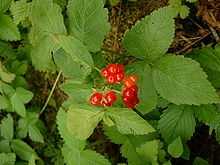Rubus saxatilis
| Rubus saxatilis | |
|---|---|
 | |
| Scientific classification | |
| Kingdom: | Plantae |
| (unranked): | Angiosperms |
| (unranked): | Eudicots |
| (unranked): | Rosids |
| Order: | Rosales |
| Family: | Rosaceae |
| Genus: | Rubus |
| Subgenus: | Cyclactis |
| Species: | R. saxatilis |
| Binomial name | |
| Rubus saxatilis L. | |
Rubus saxatilis or stone bramble is a species of bramble found in Europe (Iceland and east of the Pyrenees) and temperate Asia to Japan.[1] The green stems are 20–60 cm tall and covered with minute needle-like prickles, and leaves are usually compound with three leaflets. The spherical fruit is red and 1–1.5 cm in diameter, and contains large pips.[2]
Description
The stone bramble is a perennial plant with biennial stems which die after fruiting in their second year. It sends out long runners which root at the tip to form new plants. The stems are rough with many small spines. The alternate leaves are stalked and the leaf blades are palmate in shape. Each consists of three oval leaflets with serrated margins, the terminal leaflet having a short stalk and the other two being slightly smaller. The inflorescence is a few-flowered corymb. The calyx of each flower has five sepals and the corolla is composed of five narrow white petals. There is a bunch of stamens and there are several pistils. The fruit is an aggregate of several red, fleshy drupes.[3]
Habitat
The stone bramble can form dense clumps, spreading by means of its runners. It can also spread by seed as its edible fruit are eaten by birds which deposit the seeds elsewhere in their droppings. It flourishes in damp woods and rough places and can grow vigorously in clearings created by felling trees.[3]
Uses
Edible uses
The berries are edible raw or cooked,[1] and have an acid flavor,[1] but are agreeable to the palate.[1] In Russian cuisine, they are eaten plain with sugar, honey, or milk, and can be used in preparation of kissel, kompot, juice, syrup, jams and jellies, and kvass.[4]
Medicinal uses
Many parts of the plant are astringent, owing largely to the presence of tannins. A decoction of the root was once used in India for the treatment of relaxed bowels and dysentery, and also in treating the spasmodic stage of whooping cough. A decoction of the leaves was used to treat dysentery and some types of bleeding.[5]
Other uses
A purple to dull blue dye can be obtained from the fruit.[1]
References
- ↑ 1.0 1.1 1.2 1.3 1.4 "Plants for a Future Plant Database: Rubus saxatilis (Stone Bramble)". Retrieved 18 October 2012.
- ↑ "Encyclopedia of Life: Rubus saxatilis (Greenland Thornless Blackberry)". Retrieved 18 October 2012.
- ↑ 3.0 3.1 "Stone bramble: Rubus saxatilis". NatureGate. Retrieved 2013-12-29.
- ↑ http://rostok.ecosem.ru/recept/kostyanika.htm[]
- ↑ Chopra, Ram Nath. "Rubus saxatilis". Glossary of Indian Medicinal Plants, pp 216. Council of Scientific & Industrial Research (India), 1956.
External links
| Wikimedia Commons has media related to Rubus saxatilis. |